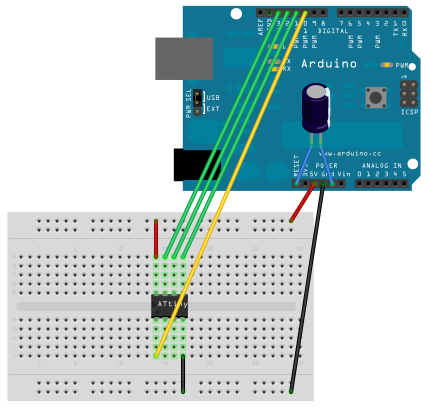This week, I’m hoping to create an appropriate enclosure for my laser etching art from last week. A very rough sketch below:

As so often happens, I feel a bit encumbered by parts of the project that seem completed unrelated to the assignment at hand. I really want to make the whole thing work without sacrificing my entire Arduino Uno to the endeavor. I’m not entirely sure what the limits to working with a microcontroller IC might be, but this assignment seems a good a reason as any to find out.
I’m looking at this Instructable for reference: Use a $1 ATTiny to Drive Addressable RGB LEDs.
Basically, it suggests that I can use an ATtiny85 instead of my Arduino Uno to drive my Neopixels. Perfect! It seems that the maker had been able to successfully run Neopixel’s strandtest using just the ATtiny85, and I won’t need anything much more complicated than that.
The next bit I had to figure out was how to program my ATtiny85, and luckily, the internet continues to be a reliable resource for all my how-to questions. You could buy a tiny AVR programmer for $15…
OR, you could use your Arduino as the ISP. Ding, ding, ding, we have a winner. How-to, in loving detail at high-low tech.

I wanted to be a bit price-conscious for this project, and I love the possibility of making something interesting from only the components and ICs we have for free in the ITP shop.
It took a bit to get my Arduino programmed as the ISP and then have the correct Neopixel code loaded onto my ATTiny85, but it works!
I really hate dedicating my Arduino to some single-use project for any amount of time, and I don’t want to spend the money buying additional microcontrollers when we have microcontroller chips for free in the shop. The ATTiny85 is the perfect antidote to my woes – I’m going to save soooo much money, and maybe be forced to write slightly more efficient code. I heard a lot of “just make it easier for yourself” as I was working on this, but honestly, that just sounds like, “just make it more boring for yourself.”
Now to actually program in the light patterns I want. I’ve been playing around with Neopixels for other projects, so I do have some working code to reuse here. I’m holding off on constructing the actual enclosure until I know for sure what buttons I’d want to include (and of course, what their functions would be). Playing with the ATTiny85 has been really helpful in letting me see what is possible.
What ended up happening as this assignment progressed is that as I switched to finally fabricating the box in question, I realized I had little to no time for the electronics.
To design the enclosure, I modified a Makercase box by removing the finger joints. This was one of my major missteps – I forgot to take into consideration the width of the material on all of the sides. This made construction a bit tighter than I had originally hoped and made quite a bit of my measuring and planning moot.
The plywood I had purchases was also much thicker than anything I had put into the lasercutter before, and it look a really long time. It was also my first time using wood, and I was a bit displeased with how burnt the edges looked.
In the rush of assembly, I accidentally glued the front of the box to the wrong aside of an adjoining piece.

The finished piece looks like this, and I think it might be the worst thing I’ve ever made:

